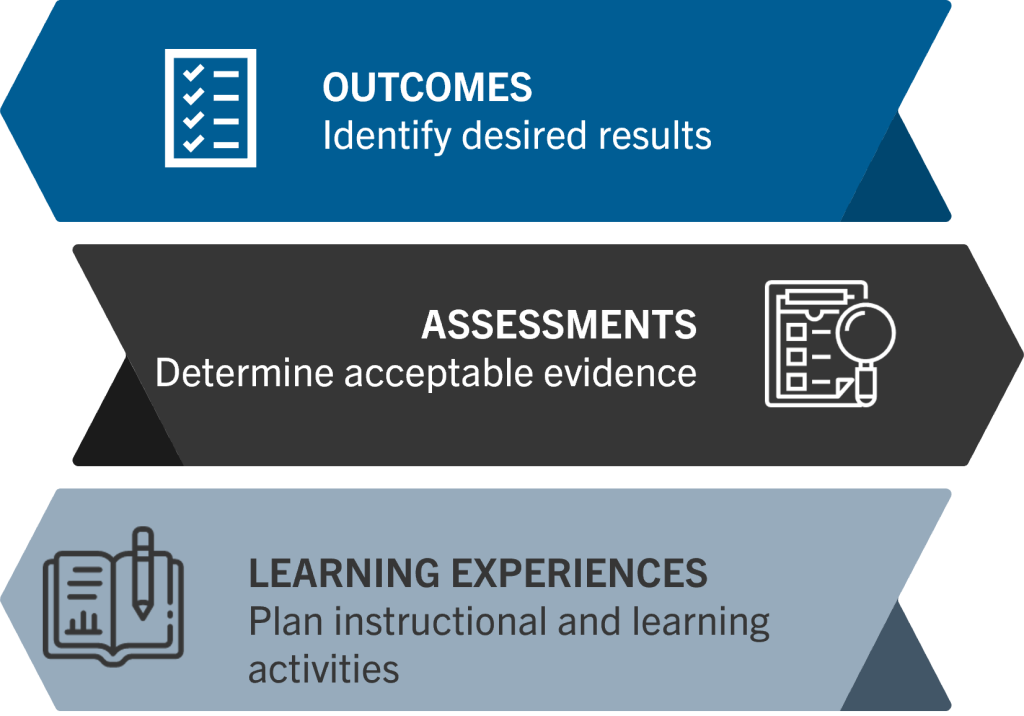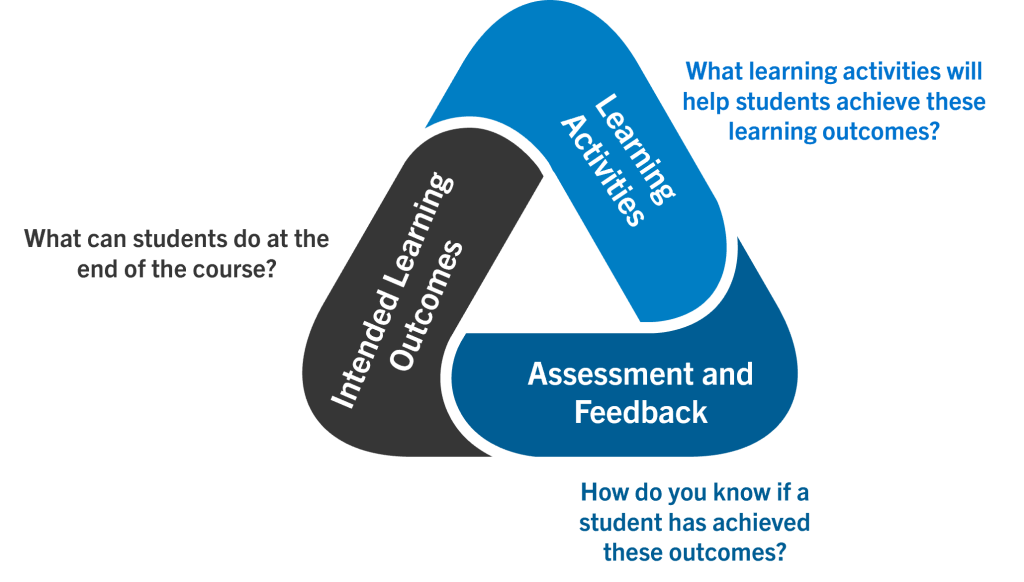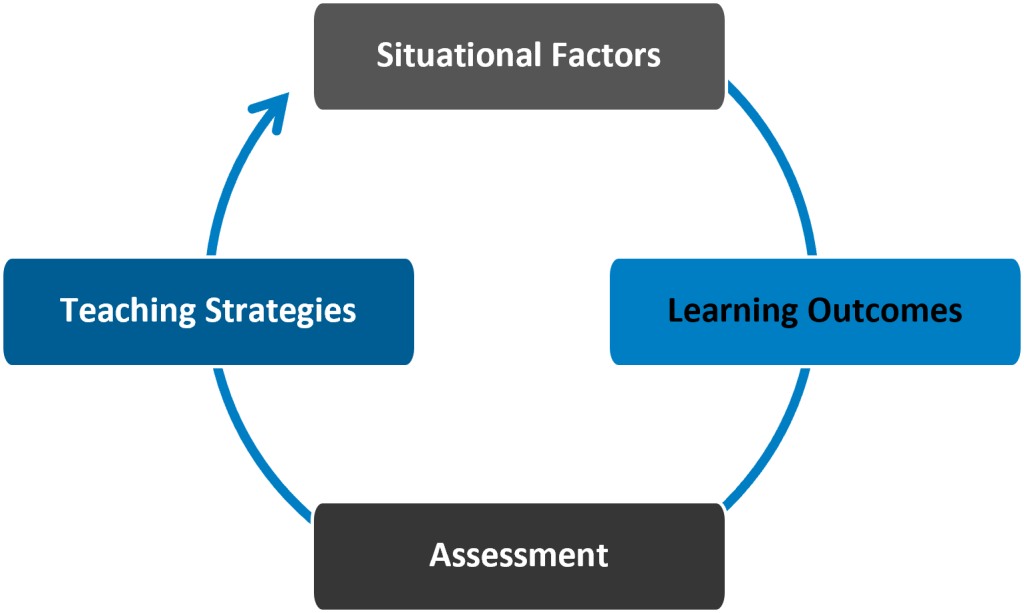Niagara College Course Design Approach
At Niagara College, we use a course design approach based on the principles of constructive alignment and integrated design. Both principles use backwards design as the foundational framework for designing courses.
Backwards Design
“Begin with the end in mind.”
Backward design —developed by Wiggins and McTighe (1998) — is an intentional course planning framework that focuses on the process of student learning and the desired learning outcomes.
Many new instructors often approach course design in a traditional method that starts by assembling course materials and then distributing the content across a set number of weeks. This content-centric approach often sets instructors up to ‘teach to content’ rather than focus on the learning process.
Backward design helps an instructor plan a course by identifying meaningful learning outcomes that articulate the course/program goals and learning objectives. Once the desired learning outcomes are set, appropriate assessments are determined before the instructional methods or learning activities or tasks are developed.
Backward design entails three stages or related planning activities:
- Identify Learning Outcomes: What students are expected to know or do at the end of the course is determined and the outcomes and objectives for the course are created.
- Design Assessment: Once the outcomes and objectives are established, assessments are developed that will show whether students have achieved the outcomes and objectives.
- Plan Learning Experiences: After the outcomes, objectives, and assessments have been determined, the course content can be built to support students in meeting those learning goals.
We know that all forms of nature and human activity — including teaching and learning — does not exist in a linear path. So, you may want to envision these stages of key course design and planning activities as an iterative cycle (see figure 1 below).
Figure 1. Backwards Design Iterative Cycle
Take a moment and watch this 5-minute video about the purpose and value of backward course design.
“Teaching is not just about engaging students in content…it is also about ensuring students have the resources necessary to understand.”
– Ryan S. Bowen (2017)
Constructive Alignment
As a college, we are required to ensure that our students meet provincial program standards for their chosen diploma or degree. To do this, we incorporate constructive alignment into our design approach.
Constructive alignment is based on the premise that students construct knowledge through intentional activities aligned in purpose to meet the desired learning outcomes. Like backwards design, constructive alignment — developed by John Biggs (1996)— reinforces the value of the critical course components — learning outcomes, assessments and learning activities — and backward planning approaches. In constructive alignment however, the course components are clearly documented and mapped to one another so that students can easily see how the learning activities and assessment will help them achieve the learning outcomes.
“Constructive alignment is a design for teaching in which what it is intended students should learn and how they should express their learning is clearly stated before teaching takes place. Teaching is then designed to engage students in learning activities that optimize their chances of achieving those outcomes, and assessment tasks are designed to enable clear judgments as to how well those outcomes have been attained.” — Biggs, 2014, pp. 5-6.
The documenting of the intentional connection between learning outcomes, assessment, and teaching and learning activities acts as a form of quality check, from lesson plans to programs. It supports positive academic outcomes because it makes teaching and learning goals and methods aligned (well organized, consistent) and explicit (obvious, visible). At the institutional level, intentional alignment assessments build better quality programs and more satisfied students.
For Example: in the Construction Tools and Techniques course the below course outcomes and objectives are shared with students in a course outline.
| Course Outcomes | Learning Objectives |
| 1. Select the correct tool or equipment for specific tasks from a variety of tools and equipment typical within the residential and light commercial construction industry.
|
1.1 Identify and select appropriate tool based upon power source, including gasoline, electrical, battery and pneumatic tools
1.2 Identify and select appropriate tool based upon job requirements, safety, and productivity |
| 2. Store, inspect and maintain of a variety of tools and equipment typical within the residential and light commercial construction industry. | 2.1 Store and transport portable power tools and equipment following correct industry practices.
2.2 Inspect power tools and equipment thoroughly prior to and following use 2.3 Explain the processes of maintaining portable power tools and equipment to ensure safety and productivity |
Then, in the Teaching and Learning Plan, a course plan is shared with students. This plan indicates how the topics, assessments, and activities for each week (columns 1 to 3) are aligned with the course objectives featured in the course outline (column 4).
| Week | Topic / Theme | Assessments and Activities | Learning Objectives |
| Week 1 | Introduction to the shop space and numerous industry typical tools. Shop safety and tool usage policies will be covered. | Staff introduction, shop tour, safety policies, course expectations, PPE, tools storage and access.
Assess: Individual shop policy / tool identification quiz. |
1.1
1.2 2.1 2.2 2.3 |
| Week 2 | 110- and 220-volt corded power tool usage and safety will be discussed and practiced. | Shop safety policy review. Corded electrical tool safety and usage. Students will identify, select and use corded electrical power tools to complete industry typical tasks.
Assess: Work preparedness, tool quiz, practical evaluation |
1.1
1.2, 2.1, 2.2 2.3 |
Integrated Course Design
While course design at Niagara College is firmly grounded in constructive alignment, we also recognize that situational factors and other context-specific considerations play an important role in how courses are structured. Because of this, we incorporate the principles of integrated course design in our development process.
Developed by Fink (2003), integrated course design, like constructive alignment, is a learning-focused design framework that promotes working backward from the course outcomes through the assessments to the content. Fink (2003) believed that in addition to backward design, the teacher-student interaction shaped and influenced learning. And, that the instructor should first assess and review the situational and contextual factors — such as course delivery format, class size, and available resources — that might impact the learners.
Because these factors can have a significant impact on teaching and learning, considering them as an ongoing part of the course design process will help to ensure that the course accounts for a range of factors. It also helps the instructor tailor and create significant learning opportunities.
Figure 2. “Backward and Integrated Design Cycle” adapted from L. Dee Fink
As you move through this guide you will see these principles in practice as we begin the development process. In Establishing Course Context, you will identify the situational factors for your course. In Course Outlines and Teaching and Learning Plans, you will develop and align your course components — course outcomes, assessments, and teaching and learning activities.
References
Biggs, J. (2014). Constructive alignment in university teaching. HERDSA Review of Higher Education, 1, 5-22.
Bowen, R. S. (2017). Understanding by Design. Vanderbilt University Center for Teaching. Retrieved from https://cft.vanderbilt.edu/understanding-by-design/
Fink, L. D. (2003). A Self-Directed Guide to Designing Courses for Significant Learning. University of Oklahoma. Retrieved from https://www.bu.edu/sph/files/2014/03/www.deefinkandassociates.com_GuidetoCourseDesignAug05.pdf
Wiggins, Grant, and McTighe, Jay. (1998). Backward Design. In Understanding by Design (pp. 13-34). ASCD.
Represent the knowledge, skills, attitudes, and experience that are taught and evaluated in a course
Describe what the students will know or be able to do by the end of the lesson; align with and further clarify the Learning Outcomes.
Activities the students will engage in throughout the course; includes how the students will interact with the course material and demonstrate their understanding of the Learning Outcomes.
A document that summarizes essential course information, identifies responsibilities and expectations of students, professors, and the College, and represents a contractual agreement.
A document that outlines the basic elements of a course including what topics will be covered, a weekly schedule, and a list of activities, tests, assignments, and their associated weightings and due dates.



